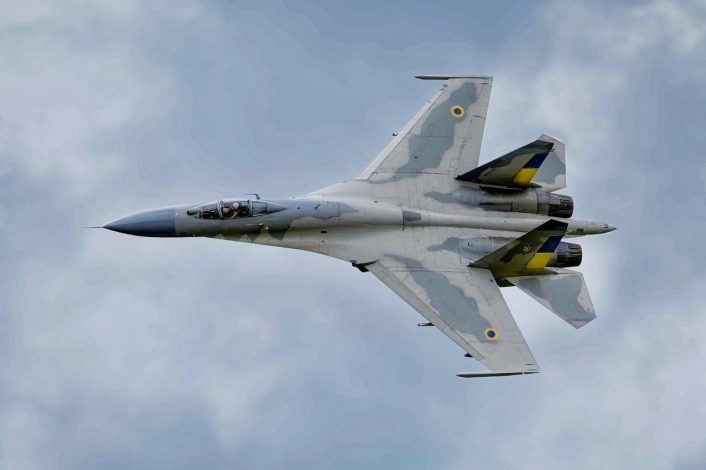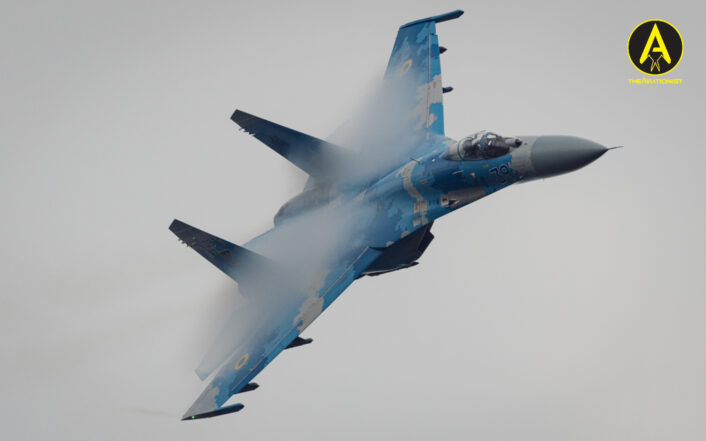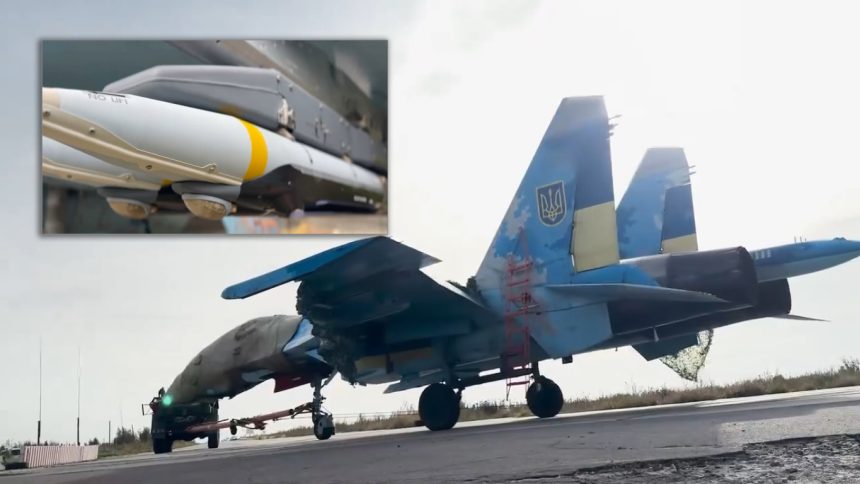A video showcasing the work of the Ukrainian logistics forces shows the GBU-39s being loaded on a Su-27. Moreover, the video shows for the first time the AIM-9Xs delivered to Ukraine.
Few months after the first sighting on the MiG-29 Fulcrum, we now got the first clear look at the U.S.-made GBU-39 Small Diameter Bomb being loaded on a Ukrainian Su-27 Flanker. Earlier photos already claimed to show the new weapon on the Su-27, however the details did not allow to identify the aircraft and the photos were later revealed to show a MiG-29.
The SDBs were shown in a recently released video showcasing the work of the Ukrainian logistics forces, which also shows for the first time a crate of AIM-9X missiles after their delivery to Ukraine. The bombs were loaded on the Su-27 with their BRU-61 quadruple rack and carried by a custom adapter under the jet’s original pylon.
A Ukrainian Su-27 with GBU-39 bombs. pic.twitter.com/XHktK6nDdM
— 𝔗𝔥𝔢 𝕯𝔢𝔞𝔡 𝕯𝔦𝔰𝔱𝔯𝔦𝔠𝔱△ 🇬🇪🇺🇦🇺🇲🇬🇷 (@TheDeadDistrict) October 11, 2024
Similarly to the MiG-29, the Su-27 can carry a total of eight of these 250-pound-class weapons, with the racks positioned at the innermost pylon of each wing. The Ukrainian military first announced the use of the GBU-39 in May 2024, around the same time the first photo of the MiG-29 carrying the new weapon emerged.
The GBU-39 has been reported as largely resilient to the Russian electronic warfare systems, contrary to the ground launched variant GLSDSB whose effectiveness took a plunge due to jamming. Ukraine claims about 90% of the SDBs employed have struck their assigned targets.
full video of 🇺🇦 logistics forces pic.twitter.com/UOEr2tT7yV
— ✙ 🔼Constantine 🔼✙ (@Teoyaomiquu) October 12, 2024
The Ukrainian Su-27s’ employment
Ukrainian Su-27s have played a crucial role in combat operations during the ongoing conflict with Russia. Pilots have reported dramatic experiences of aerial combat against the Russian Air Force, showcasing the intensive effort needed to prevent Russia achieving air superiority.
The 831st Tactical Aviation Brigade of Ukraine, the first frontline unit to receive the Su-27 in 1985, has a long history of service that includes joint exercises with other NATO nations and significant combat missions. The unit is employing the aircraft both in the air-to-air role, using the Soviet era AA-10 Alamo and AA-11 Archer missiles, and the air-to-ground role, using the Western-made AGM-88 HARM, GBU-62 JDAM-ER, AASM Hammer and GBU-39 SDB.
✈️🚀 Launch of two AGM-88 HARM anti-radar missiles from a Ukrainian Su-27. pic.twitter.com/hECsG0rqjN
— Slava 🇺🇦 (@Heroiam_Slava) August 21, 2024
The Su-27 has been used by both Ukraine and Russia, but there are significant differences in their configurations and uses. While Ukraine has reportedly updated its fleet with new avionics and radars, Russia has developed the Su-35 as an evolution of the Su-27. The Russian Su-35 is equipped with more advanced avionics, AESA (Active Electronically Scanned Array) radar and improved weapons systems.
These upgrades offer greater range and precision in weapon systems, significantly enhancing the Su-35’s combat capability over the Su-27 and thus making the Ukrainians disadvantaged. Despite the technological superiority of the Su-35, the experience and tactics of Ukrainian pilots have allowed them to effectively use the Su-27 and make the most of available resources.

F-15-inspired camouflage
The Ukrainian Air Force has recently published on its social media channels a photo of a Su-27 Flanker with an interesting livery, inspired to the F-15C’s Compass Ghost Gray camouflage. The photo was immediately shared by multiple accounts as that was reportedly the first high-resolution photo of that camo, which has been spotted so far on three different jets.
According to the caption shared with the photo on Telegram, the photo was captured in July 2024 and shows a Su-27S assigned to the 831st Tactical Aviation Brigade. Some sources added that this aircraft might have been recently refurbished, however details are unknown.
At least 3 Ukrainian Air Force Su-27 were painted with this type of ‘Eagle Camo’, don’t mix them up https://t.co/wx6aYTSKiq pic.twitter.com/UrpN7uuKXT
— Fighterman_FFRC (@Fighterman_FFRC) September 24, 2024
While unarmed, the aircraft can be seen equipped with the custom pylons used for either the GBU-62 JDAM-ER or the AASM Hammer munitions. A definitive identification is not possible, however we can recognize in the photo the black GPS antenna which is present on both pylons.
Ukraine’s adoption of a US-inspired camouflage scheme could point to an effort aimed at reducing the vulnerability of its Su-27s to enemy air defenses and aircraft. The Compass Ghost Gray camouflage is said to be designed to minimize the F-15’s visibility from both ground-based and airborne threats, and Ukraine’s decision to adopt a similar scheme for its Su-27s suggests a similar goal of minimizing their visual detectability.
Contrary to the MiG-29, which was operated by multiple European countries who then donated their aircraft after the start of the war, Ukraine is the continent’s sole Su-27 operator outside Russia and Belarus. Because of this, Ukraine is trying to protect the highly valuable fleet of Su-27s as, otherwise, it would not be possible to source replacement aircraft.

The Ukrainian Su-27 fleet
When the Soviet Unition collapsed in 1991, Ukraine inherited up to 70 Su-27s. Among them were some of the oldest of the Soviet Air Force, as the 831st Tactical Aviation Brigade (Tactical Aviation Regiment in Soviet era) was the first frontline unit to receive the Flanker in 1985.
Throughout the years, the number of aircraft in service decreased because of the high maintenance requirements and a shortage of spare parts, with only up to 26 aircraft airworthy in 2021. Many Su-27s were stored, while nine were sold abroad, including the one which is now at the U.S. Air Force Museum.
Among the aircraft in Ukraine there are different variants, including the initial Su-27S delivered in the 1980s (around 40 airframes), the air-to-air-only Su-27P (about a dozen) and the twin-seaters Su-27UB and Su-27PU. In addition to these, Ukraine has the upgraded Su-27S1M, Su-27P1M, Su-27UBM1 and Su-27PU1M variants.
The upgrades were performed in the early 2010s and included structural modifications to extend the service life of the aircraft. It is reported that the modernization was also meant to bring some components to NATO standards, with new radios and GPS systems, as well as minor overhaul of the radar.
As already known, with the help of the United States, Ukraine integrated new air-to-ground weapons on the Su-27, namely the U.S.-made AGM-88 HARM, GBU-62 JDAM-ER and GBU-39 SDB and the French-made AASM Hammer. Ukraine is also expected to receive the British-supplied Paveway IV dual-mode GPS/laser-guided bombs, although it’s unclear on which aircraft they will be integrated.
According to unconfirmed reports, Ukraine also tried to integrate U.S.-made air-to-air weapons on the MiG-29 and Su-27, although the effort was not successful and the aircraft are still relying on the Soviet-era R-27/AA-10 Alamo and R-73/AA-11 Archer missiles. It’s unclear which weapon Ukraine tried to integrate, although both AIM-120 AMRAAM and AIM-9 were delivered and used by both NASAMS air-defense systems and F-16s.









